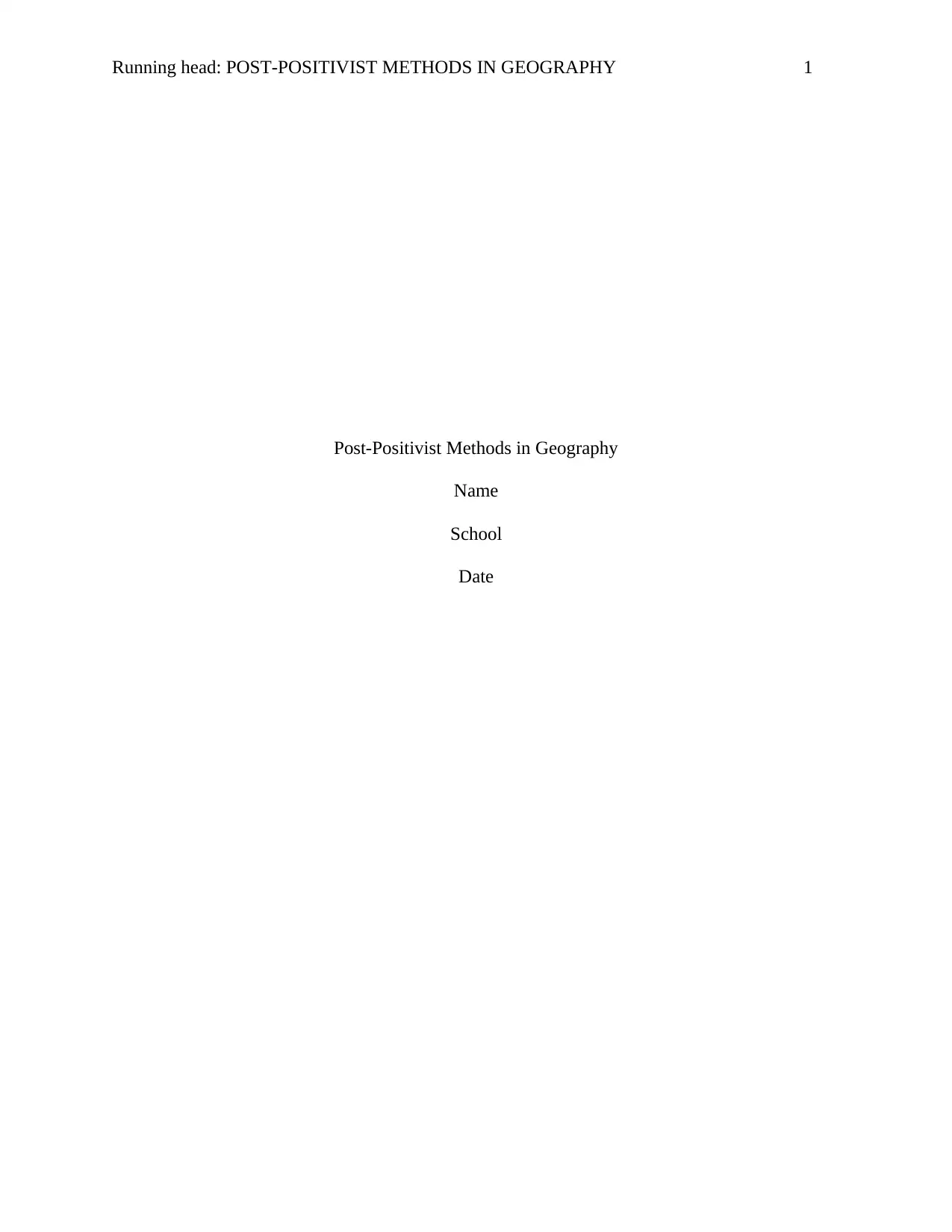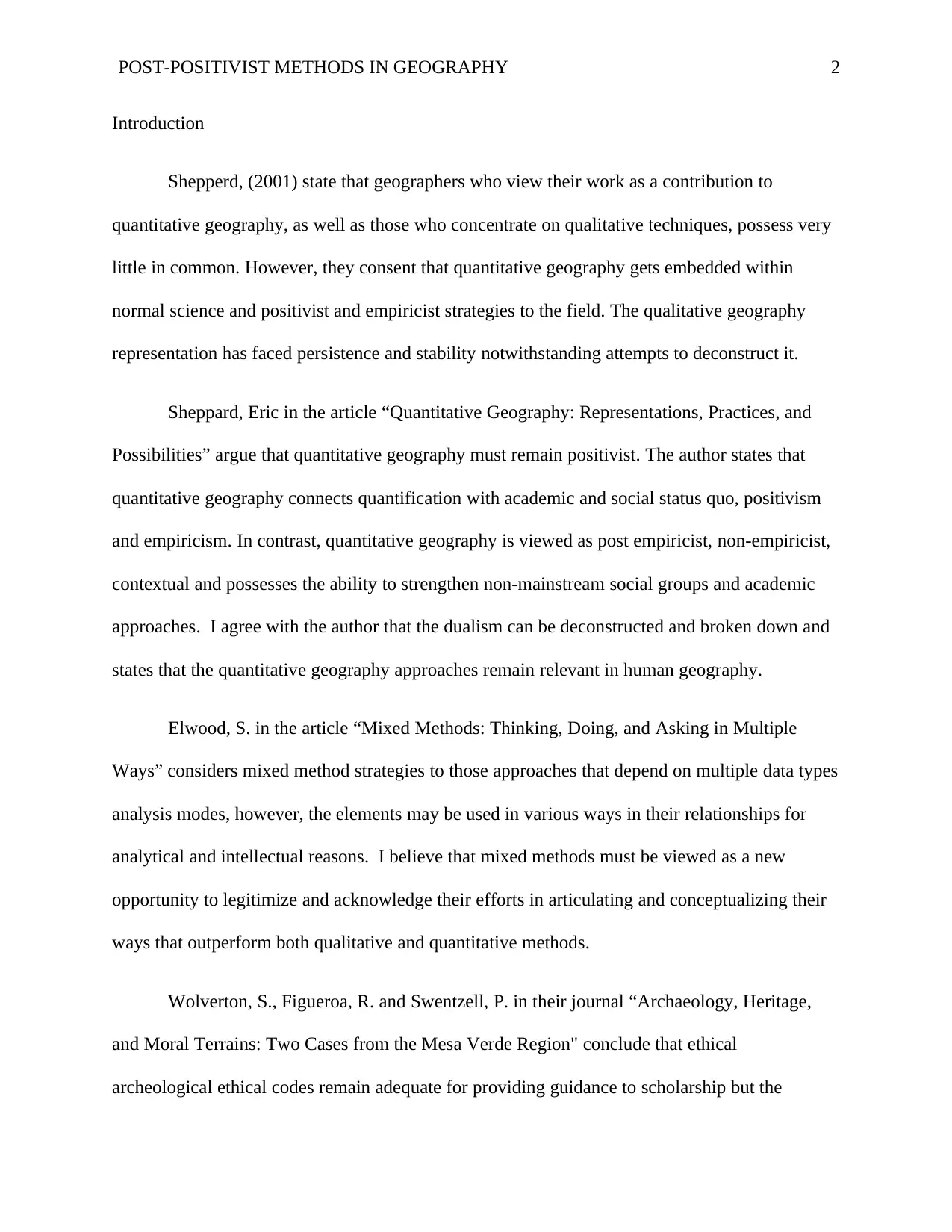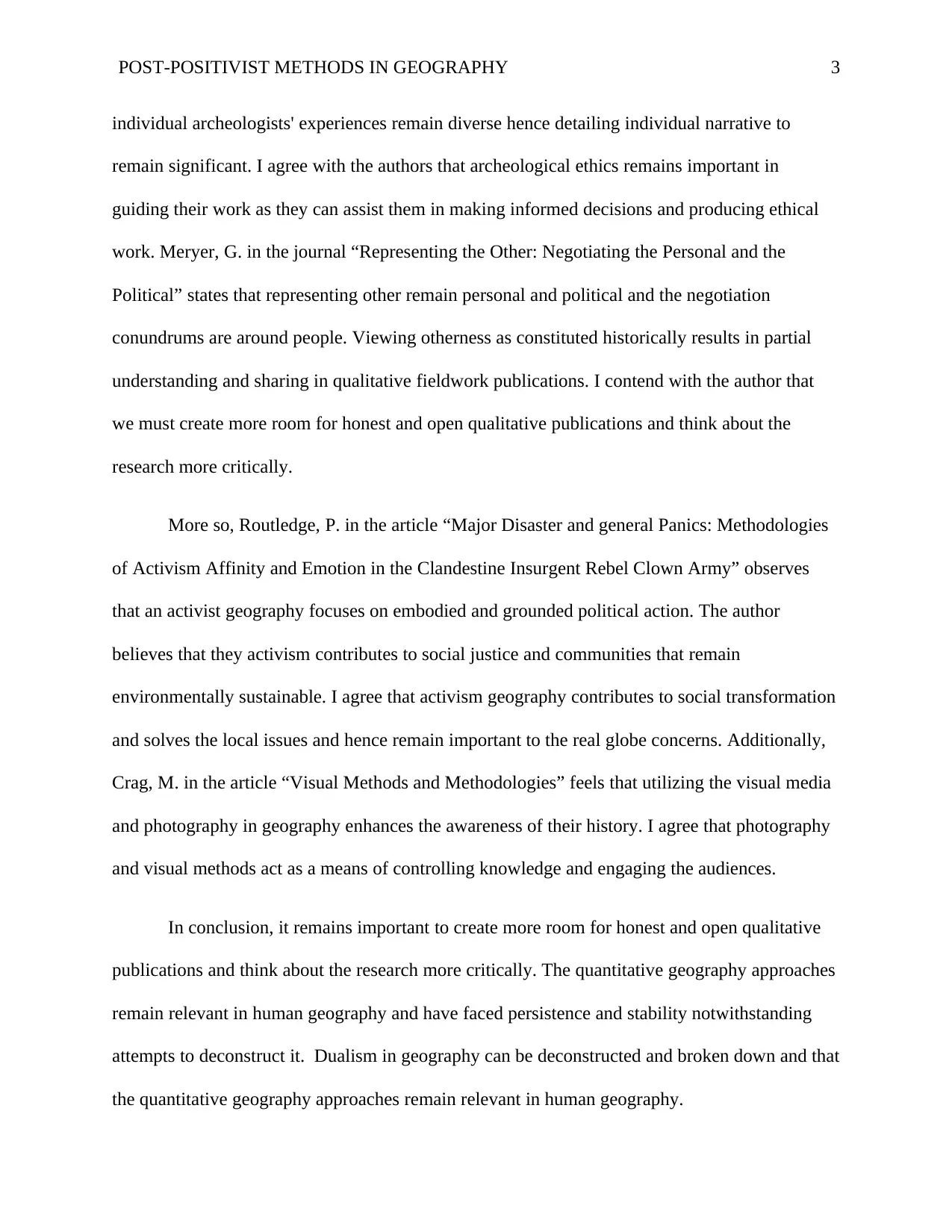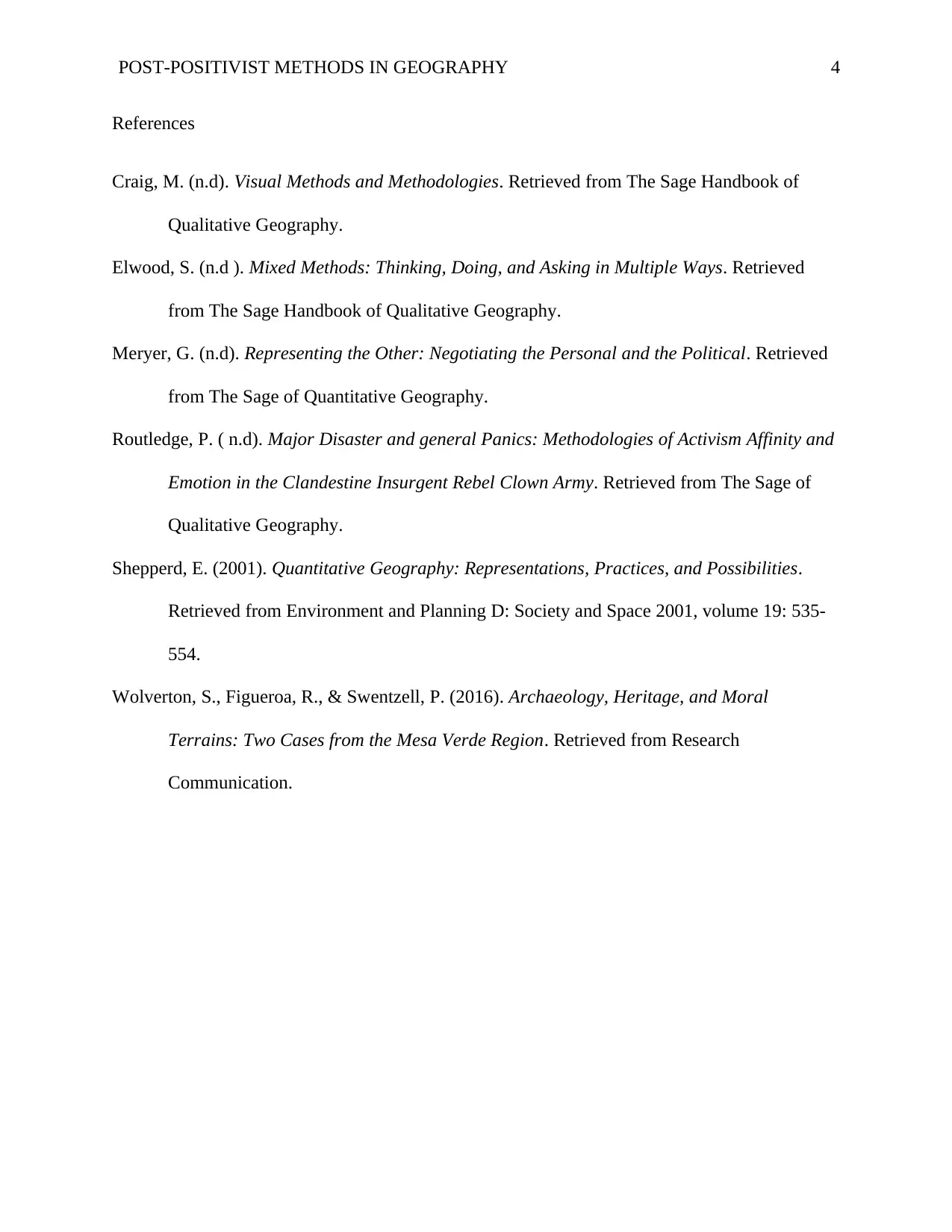Examining the Application of Post-Positivist Methods in Geography
VerifiedAdded on 2023/06/03
|4
|833
|263
Essay
AI Summary
This essay provides an overview of post-positivist methods in geography, addressing the historical dualism between quantitative and qualitative approaches. It analyzes various perspectives, including the relevance of quantitative geography, the benefits of mixed methods, the importance of ethical considerations in archeology, and the role of activist geography in social transformation. The essay emphasizes the need for honest and critical qualitative publications and concludes that quantitative geography remains relevant in human geography despite attempts to deconstruct it. The discussion references several articles and journals to support its arguments, highlighting the diverse and evolving landscape of geographical research methodologies.

Running head: POST-POSITIVIST METHODS IN GEOGRAPHY 1
Post-Positivist Methods in Geography
Name
School
Date
Post-Positivist Methods in Geography
Name
School
Date
Paraphrase This Document
Need a fresh take? Get an instant paraphrase of this document with our AI Paraphraser

POST-POSITIVIST METHODS IN GEOGRAPHY 2
Introduction
Shepperd, (2001) state that geographers who view their work as a contribution to
quantitative geography, as well as those who concentrate on qualitative techniques, possess very
little in common. However, they consent that quantitative geography gets embedded within
normal science and positivist and empiricist strategies to the field. The qualitative geography
representation has faced persistence and stability notwithstanding attempts to deconstruct it.
Sheppard, Eric in the article “Quantitative Geography: Representations, Practices, and
Possibilities” argue that quantitative geography must remain positivist. The author states that
quantitative geography connects quantification with academic and social status quo, positivism
and empiricism. In contrast, quantitative geography is viewed as post empiricist, non-empiricist,
contextual and possesses the ability to strengthen non-mainstream social groups and academic
approaches. I agree with the author that the dualism can be deconstructed and broken down and
states that the quantitative geography approaches remain relevant in human geography.
Elwood, S. in the article “Mixed Methods: Thinking, Doing, and Asking in Multiple
Ways” considers mixed method strategies to those approaches that depend on multiple data types
analysis modes, however, the elements may be used in various ways in their relationships for
analytical and intellectual reasons. I believe that mixed methods must be viewed as a new
opportunity to legitimize and acknowledge their efforts in articulating and conceptualizing their
ways that outperform both qualitative and quantitative methods.
Wolverton, S., Figueroa, R. and Swentzell, P. in their journal “Archaeology, Heritage,
and Moral Terrains: Two Cases from the Mesa Verde Region" conclude that ethical
archeological ethical codes remain adequate for providing guidance to scholarship but the
Introduction
Shepperd, (2001) state that geographers who view their work as a contribution to
quantitative geography, as well as those who concentrate on qualitative techniques, possess very
little in common. However, they consent that quantitative geography gets embedded within
normal science and positivist and empiricist strategies to the field. The qualitative geography
representation has faced persistence and stability notwithstanding attempts to deconstruct it.
Sheppard, Eric in the article “Quantitative Geography: Representations, Practices, and
Possibilities” argue that quantitative geography must remain positivist. The author states that
quantitative geography connects quantification with academic and social status quo, positivism
and empiricism. In contrast, quantitative geography is viewed as post empiricist, non-empiricist,
contextual and possesses the ability to strengthen non-mainstream social groups and academic
approaches. I agree with the author that the dualism can be deconstructed and broken down and
states that the quantitative geography approaches remain relevant in human geography.
Elwood, S. in the article “Mixed Methods: Thinking, Doing, and Asking in Multiple
Ways” considers mixed method strategies to those approaches that depend on multiple data types
analysis modes, however, the elements may be used in various ways in their relationships for
analytical and intellectual reasons. I believe that mixed methods must be viewed as a new
opportunity to legitimize and acknowledge their efforts in articulating and conceptualizing their
ways that outperform both qualitative and quantitative methods.
Wolverton, S., Figueroa, R. and Swentzell, P. in their journal “Archaeology, Heritage,
and Moral Terrains: Two Cases from the Mesa Verde Region" conclude that ethical
archeological ethical codes remain adequate for providing guidance to scholarship but the

POST-POSITIVIST METHODS IN GEOGRAPHY 3
individual archeologists' experiences remain diverse hence detailing individual narrative to
remain significant. I agree with the authors that archeological ethics remains important in
guiding their work as they can assist them in making informed decisions and producing ethical
work. Meryer, G. in the journal “Representing the Other: Negotiating the Personal and the
Political” states that representing other remain personal and political and the negotiation
conundrums are around people. Viewing otherness as constituted historically results in partial
understanding and sharing in qualitative fieldwork publications. I contend with the author that
we must create more room for honest and open qualitative publications and think about the
research more critically.
More so, Routledge, P. in the article “Major Disaster and general Panics: Methodologies
of Activism Affinity and Emotion in the Clandestine Insurgent Rebel Clown Army” observes
that an activist geography focuses on embodied and grounded political action. The author
believes that they activism contributes to social justice and communities that remain
environmentally sustainable. I agree that activism geography contributes to social transformation
and solves the local issues and hence remain important to the real globe concerns. Additionally,
Crag, M. in the article “Visual Methods and Methodologies” feels that utilizing the visual media
and photography in geography enhances the awareness of their history. I agree that photography
and visual methods act as a means of controlling knowledge and engaging the audiences.
In conclusion, it remains important to create more room for honest and open qualitative
publications and think about the research more critically. The quantitative geography approaches
remain relevant in human geography and have faced persistence and stability notwithstanding
attempts to deconstruct it. Dualism in geography can be deconstructed and broken down and that
the quantitative geography approaches remain relevant in human geography.
individual archeologists' experiences remain diverse hence detailing individual narrative to
remain significant. I agree with the authors that archeological ethics remains important in
guiding their work as they can assist them in making informed decisions and producing ethical
work. Meryer, G. in the journal “Representing the Other: Negotiating the Personal and the
Political” states that representing other remain personal and political and the negotiation
conundrums are around people. Viewing otherness as constituted historically results in partial
understanding and sharing in qualitative fieldwork publications. I contend with the author that
we must create more room for honest and open qualitative publications and think about the
research more critically.
More so, Routledge, P. in the article “Major Disaster and general Panics: Methodologies
of Activism Affinity and Emotion in the Clandestine Insurgent Rebel Clown Army” observes
that an activist geography focuses on embodied and grounded political action. The author
believes that they activism contributes to social justice and communities that remain
environmentally sustainable. I agree that activism geography contributes to social transformation
and solves the local issues and hence remain important to the real globe concerns. Additionally,
Crag, M. in the article “Visual Methods and Methodologies” feels that utilizing the visual media
and photography in geography enhances the awareness of their history. I agree that photography
and visual methods act as a means of controlling knowledge and engaging the audiences.
In conclusion, it remains important to create more room for honest and open qualitative
publications and think about the research more critically. The quantitative geography approaches
remain relevant in human geography and have faced persistence and stability notwithstanding
attempts to deconstruct it. Dualism in geography can be deconstructed and broken down and that
the quantitative geography approaches remain relevant in human geography.
⊘ This is a preview!⊘
Do you want full access?
Subscribe today to unlock all pages.

Trusted by 1+ million students worldwide

POST-POSITIVIST METHODS IN GEOGRAPHY 4
References
Craig, M. (n.d). Visual Methods and Methodologies. Retrieved from The Sage Handbook of
Qualitative Geography.
Elwood, S. (n.d ). Mixed Methods: Thinking, Doing, and Asking in Multiple Ways. Retrieved
from The Sage Handbook of Qualitative Geography.
Meryer, G. (n.d). Representing the Other: Negotiating the Personal and the Political. Retrieved
from The Sage of Quantitative Geography.
Routledge, P. ( n.d). Major Disaster and general Panics: Methodologies of Activism Affinity and
Emotion in the Clandestine Insurgent Rebel Clown Army. Retrieved from The Sage of
Qualitative Geography.
Shepperd, E. (2001). Quantitative Geography: Representations, Practices, and Possibilities.
Retrieved from Environment and Planning D: Society and Space 2001, volume 19: 535-
554.
Wolverton, S., Figueroa, R., & Swentzell, P. (2016). Archaeology, Heritage, and Moral
Terrains: Two Cases from the Mesa Verde Region. Retrieved from Research
Communication.
References
Craig, M. (n.d). Visual Methods and Methodologies. Retrieved from The Sage Handbook of
Qualitative Geography.
Elwood, S. (n.d ). Mixed Methods: Thinking, Doing, and Asking in Multiple Ways. Retrieved
from The Sage Handbook of Qualitative Geography.
Meryer, G. (n.d). Representing the Other: Negotiating the Personal and the Political. Retrieved
from The Sage of Quantitative Geography.
Routledge, P. ( n.d). Major Disaster and general Panics: Methodologies of Activism Affinity and
Emotion in the Clandestine Insurgent Rebel Clown Army. Retrieved from The Sage of
Qualitative Geography.
Shepperd, E. (2001). Quantitative Geography: Representations, Practices, and Possibilities.
Retrieved from Environment and Planning D: Society and Space 2001, volume 19: 535-
554.
Wolverton, S., Figueroa, R., & Swentzell, P. (2016). Archaeology, Heritage, and Moral
Terrains: Two Cases from the Mesa Verde Region. Retrieved from Research
Communication.
1 out of 4
Your All-in-One AI-Powered Toolkit for Academic Success.
+13062052269
info@desklib.com
Available 24*7 on WhatsApp / Email
![[object Object]](/_next/static/media/star-bottom.7253800d.svg)
Unlock your academic potential
Copyright © 2020–2025 A2Z Services. All Rights Reserved. Developed and managed by ZUCOL.